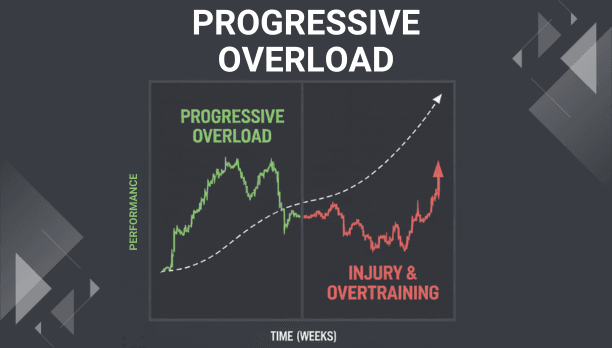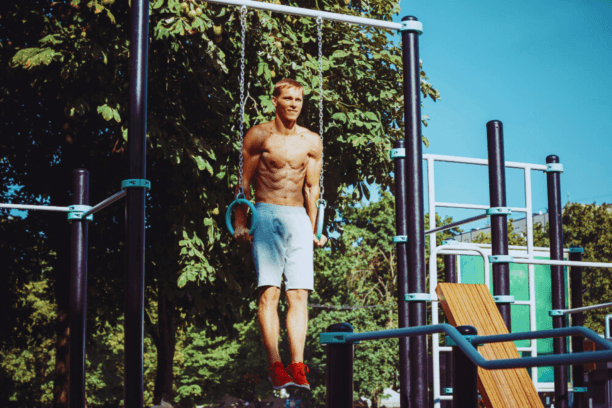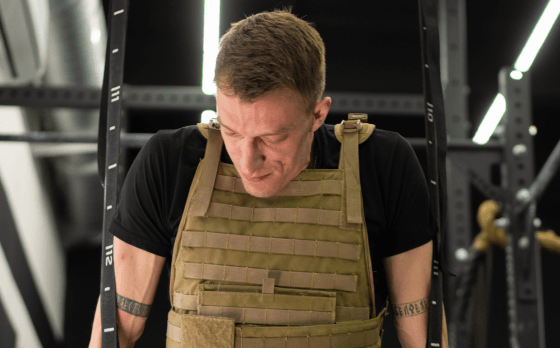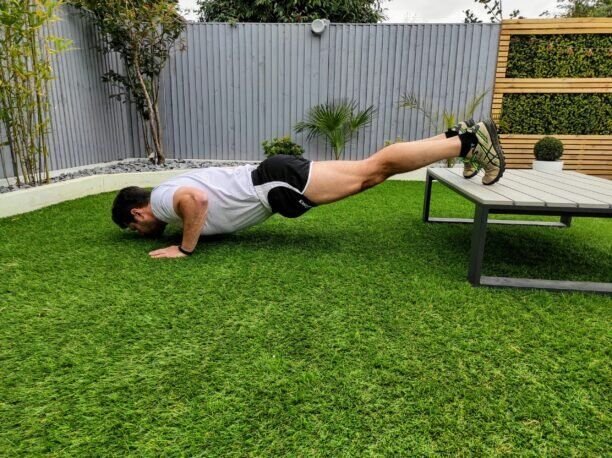Think you’ve hit a ceiling with your calisthenics gains? Think again!
Progressive overload… the gradual increase of weight, frequency, or number of repetitions in your strength training routine is the key to continuous muscle growth. And yes, it applies to bodyweight training too!
Building muscle with calisthenics is not only possible but highly effective when done correctly.
Table of Contents
Understanding Progressive Overload in Calisthenics

Progressive overload is the cornerstone of any effective strength training program, including calisthenics. But how does it work, and why is it so crucial for your gains?
The Science Behind Muscle Growth and Adaptation
When you challenge your muscles beyond their current capacity, you create microscopic damage to the muscle fibers.
During recovery, your body repairs this damage, making the muscles stronger and larger to better handle future stress.
This adaptation is the essence of muscle growth and without it, you simply won’t get stronger or larger muscles. Proper nutrition plays a crucial role in this recovery and growth process.
Why Progressive Overload is Crucial for Continued Gains
Without progressive overload, your muscles become accustomed to the same stress level, and growth stagnates.
By consistently increasing the challenge, you force your body to continually adapt and grow.
You may find it all too easy once you get used to a program or routine and to just stick to it.
However this is where I went wrong when I was first getting started with calisthenics. I needed to keep pushing and continually making my workouts progressively harder overtime.
Challenges of Applying Progressive Overload in Bodyweight Training
One common misconception is that it’s harder to apply progressive overload in calisthenics compared to weight training.
While it’s true that you can’t simply add more plates to a barbell, there are numerous ways to increase difficulty in bodyweight exercises.
Debunking Myths About Calisthenics and Muscle Building Plateaus
Many believe that calisthenics has a ceiling for muscle growth. In my experience, this couldn’t be further from the truth. With the right techniques, you can continue to build muscle and strength with bodyweight exercises for years to come. Effective calisthenics exercises can challenge even the most advanced athletes.
To the people that say it is hard to make the calisthenics exercises more difficult. My response is: “How many; handstand push ups, one arm chin ups and planche push ups can you do?”
Unless you can do 20+ reps on each of those exercises, there is plenty of progression and you are nowhere near the ceiling for muscle growth with calisthenics.
Even if you could do all of those exercises for 20+ reps. You could do them weighted.
Increasing Repetitions and Sets

One of the most straightforward ways to apply progressive overload in calisthenics is by manipulating your rep and set schemes.
The Rep Range Sweet Spot for Hypertrophy in Calisthenics
While the traditional hypertrophy range of 8-12 reps still applies, I’ve found that pushing into higher rep ranges between 15-20 or even more can be particularly effective for calisthenics muscle building.
The higher the reps, generally you will be training slightly more muscular endurance then raw strength, however this has very good carry over within calisthenics as a lot of exercises will need the stabilization muscles to provide stability for a long duration.
Strategies for Gradually Increasing Reps Over Time
You can start by adding just one or two reps to your sets each week. This gradual increase allows your body to adapt without overwhelming it.
Once you get familiar with the exercise selection and the overall routine. I have found aiming to increase 2 reps for each set on the next workout is a good benchmark to ensure I provide adequate stimulus.
Adding Sets to Increase Overall Volume
If you’ve maxed out your rep increases, consider adding an extra set to your exercises. This increases the overall volume, a key factor in muscle growth.
While this strategy is not my favorite in making the workout harder, you can mix it up every now and then and may find you prefer this method.
Balancing High-Rep Work with Strength Maintenance
While high rep work is great for hypertrophy, don’t neglect lower rep ranges entirely. I like to include some heavy, low rep work to maintain and build strength alongside muscle size.
This could be either by utilizing harder exercise progressions to start with. eg handstand push ups or leaning planch push ups as far forward as you can.
You may find you can only do 3-5 reps in a set. I will only do this occasionally as it can be a lot of stress on the tendons and ligaments, which take a longer time to grow when compared to muscle.
So take your time to warm up and use these sparingly to allow not only the muscles to adjust but also your tendons and ligaments.
Manipulating Tempo and Time Under Tension

Changing the speed of your reps can dramatically increase the difficulty of bodyweight exercises. Ever tried to hold a plank for 5 minutes?.. It is the same principle.
Understanding the Importance of Eccentric, Isometric, and Concentric Phases
Each phase of a movement offers unique benefits. The eccentric (lowering) phase, in particular, is crucial for muscle growth.
I am to performed controlled reps making the eccentric phase about twice the time when compared to the concentric and with a slight pause on the top and bottom of the exercise.
Slow-Motion Reps for Increased Muscle Tension
Try performing your reps at half speed or even slower. You’ll feel the burn like never before!
When performing these, also try and keep as much tension on the muscle during both the eccentric and concentric phase. You may find that you have to choose a slightly easier progression to perform this on.
Paused Reps to Eliminate Momentum and Increase Difficulty
Adding a pause at the bottom of a push-up or pull-up eliminates momentum and increases time under tension.
You can try a hand release push up. So when you get to the bottom, release your hands off the ground while lying on your chest and stomach and then place your hands back down to push up. This will completely eliminate any bounce or spring effect at the bottom from your ligaments.
Combining Tempo Changes with Rep Increases for Compound Effect
For a real challenge, combine slow eccentrics with an increased rep count. Your muscles won’t know what hit them!
Decreasing Leverage for Increased Difficulty

Changing your body position can make exercises significantly more challenging.
Some exercises will cater more towards this style of progressive overload than others.
Progressing from Easier to Harder Exercise Variations
As you master one variation, move on to a more difficult one. This progression ensures continuous challenge and growth.
Examples of Leverage Changes for Common Calisthenics Exercises
- Push-ups: Standard to diamond to archer to one-arm progressions
- Pull-ups: Assisted to standard to L-sit to one-arm progressions
- Squats: Assisted to pistol squat progressions
Using Parallettes, Rings, and Bars to Alter Leverage
Equipment like rings can add an element of instability, increasing the difficulty of exercises and engaging more stabilizer muscles. You may also find the use off gymnastic rings useful as it allows your wrists to be in your naturally strongest position.
Adding External Resistance to Bodyweight Exercises

While not strictly necessary, adding external resistance can be a gam changer for progressive overload in calisthenics.
This can be a very precise method to progressive overload as there is a specific amount of weight you can directly measure.
Weighted Vests: A Game Changer for Progressive Overload
A weighted vest allows you to add resistance to virtually any bodyweight exercise. I’ve found this to be particularly effective for push-ups and pull-ups.
Try and find a weight vest that caters to your strength goals as some may not be able to make incremental weight increases or reach their weight limit too soon.
I’d opt for a weighted vest with the ability to increase the weight up to 20-30kg with plenty of room around the shoulders to provide the required mobility for pull ups and handstand push ups.
Using Resistance Bands to Add Variable Tension
Resistance bands can add tension to exercises like push-ups or make assisted versions of difficult moves like muscle-ups.
DIY Solutions for Adding Weight to Bodyweight Exercises
Don’t have equipment? No problem! A backpack filled with books or water bottles can serve as a makeshift weighted vest.
Before even getting a weighted vest I used to fill up as many water bottles as I could and put them all into a backpack and then perform weighted push ups and pull ups.
Increasing Range of Motion and Stability Challenges
Changing your range of motion or stability can make familiar exercises feel brand new.

Elevating Hands or Feet in Push Ups and Dips
Elevating your feet during push ups increases the load on your upper body. Conversely, elevating your hands can increase the range of motion.
You can also the range of motion by doing push ups on gymnastic rings or parallettes, allowing you to lower yourself much further as your chest will not hit the floor.
I’d only go as deep as it feels ‘comfortable’ as if you go too deep compared to what you are used to, you may cause an injury.
Deep Step Ups and Bulgarian Split Squats for Lower Body
These exercises allow for a greater range of motion in leg training, leading to more muscle activation.
Unstable Surface Training: Using Stability Balls and BOSU Balls
Performing exercises on unstable surfaces engages more stabilizer muscles and increases overall difficulty.
Start with a easy progression to slowly build up stability strength.
Progressing to Plyometric Variations for Explosive Strength
Plyometric exercises like clap push ups or box jumps add an explosive element to your training, promoting power development alongside muscle growth.
This can be great when you want to train for explosive movements or if you are wanting to train for the muscle up. As you will need explosive pull ups to be able to perform a muscle up.
Density Training for Progressive Overload
Manipulating your work-to-rest ratio can be an effective way to progress your workouts.
Decreasing Rest Periods Between Sets
Gradually reducing rest periods increases the overall intensity of your workout by keeping your heart rate up and not allowing the muscle to completely rest before performing another set.
Implementing Supersets and Circuit Training
Pairing exercises or creating circuits can increase workout density and provide a cardiovascular benefit.
You do perform this in 3 ways:
Circuit
You would perform each exercise back to back with no rest and then at the end of the round, you will have a short rest.
Eg. 3 rounds of this:
- Pushups
- Pull ups
- Squats
- Leg raises
- Rest 2 minutes
Superset Option 1 (my preference)
Choosing opposing muscle groups back to back.
Eg. a set of dips followed by pull ups, then rest.
Superset Option 2
Choosing an exercise that targets the same muscle group.
Eg. a set of dips followed by push ups, then rest.
AMRAP (As Many Rounds As Possible) Workouts for Calisthenics
AMRAP workouts are a great way to push your limits and track progress over time.
Track how many rounds you performed and aim to increase how many rounds you performed next time.
Tracking and Gradually Improving Workout Density Over Time
Keep track of how much work you’re doing in a given time frame and aim to improve this over weeks and months.
Periodization in Calisthenics for Consistent Progress
Structuring your training over longer periods can help ensure consistent progress and prevent plateaus.
To prevent your muscles and central nervous system adjusting to your workouts, you may want to swap the workouts, exercise selection, intensity and volume around occasionally.
Linear Periodization: Gradually Increasing Difficulty Over Time
This involves steadily increasing the challenge week by week or month by month.
Undulating Periodization: Varying Intensity and Volume
Alternating between high-volume and high-intensity workouts can provide a more varied stimulus for growth.
You may find after 2-3 months of one style of training that you are mentally craving the other or are feeling like you want to mix things up. By changing from high volume, low intensity workouts to high intensity, low volume workouts you will start to see progress come back and the new style of training will keep things fresh and new for you.
Block Periodization: Focusing on Specific Adaptations in Blocks
Dedicating blocks of time to specific goals (like strength, hypertrophy, or endurance) can lead to more focused adaptations.
You do not want to be chopping and changing too often and losing sight of your goals.
I like to stick to around 3 months for a specific goal and then after that period I will reassess.
Deload Weeks: The Importance of Planned Recovery Periods
Regular deload weeks allow your body to fully recover and come back stronger. Don’t skip these if you are doing high volume and very intense workouts.
I find if I am doing high intensity, low volume workouts just 3 days per week. I will not need a deload week nearly as often when compared to high volume workouts.
Generally once every 4-8 weeks when you find your body feeling progressively tired is when you may need a deload week.
This is on the basis you are getting enough nutrition, sleep, rest and overall recovery.
(IMAGE HERE: A graph showing a periodized calisthenics training plan over several months)
Tracking Progress and Overcoming Plateaus
Monitoring your progress is crucial for long-term success in calisthenics.
This will show not only how far you have progressed, but what style of training your body responds to best.
It shows definitive evidence that no one can argue with.
Methods for Logging Calisthenics Workouts Effectively
Use a notebook or app to track your workouts, including exercises, sets, reps, and how you felt.
I like to record the reps on each set and when performing the exercises weighted I will record the weight.
For days when I am totally exhausted and have committed myself to working out anyways, I will put this in the notes next to the workout session.
Using Video to Analyze Form and Track Progress
Recording your workouts can help you spot form issues and see progress that might not be apparent day-to-day.
Post workout, you can reflect on your form and compare to technique videos on YouTube to identify any potential shortfalls or muscle imbalances you may have.
Identifying and Breaking Through Sticking Points
Pay attention to where you struggle in exercises and focus on improving these weak points.
For me, the biggest was my grip strength when training weighted pull ups. Once I addressed this my pull up strength increased drastically.
When and How to Introduce New Exercises or Training Methods
If you’ve plateaued with one method, don’t be afraid to try something new. Variety is the spice of gains!
Conclusion:
Congratulations! You’re now equipped with a powerful arsenal of progressive overload techniques tailored for calisthenics. Remember, the key to continuous muscle growth lies in consistently challenging your body in new ways. By implementing these strategies, you’ll ensure that your muscles never get too comfortable, leading to ongoing gains in strength and size.
Start by incorporating one or two of these methods into your current routine. Pay attention to how your body responds and adjust accordingly. Don’t be afraid to experiment and find what works best for you. With patience, consistency, and these progressive overload techniques, you’ll break through plateaus and achieve muscle building results you never thought possible with just your body weight.
Ready to revolutionize your calisthenics training? Your journey to progressive, continuous muscle gains starts now. Let’s get out there and show the world the true muscle building potential of calisthenics!

Founder of www.calisthenics-101.co.uk. Training calisthenics since 2012.
Currently working on: 30 second one-arm handstand, muscle-up 360, straddle planche.
